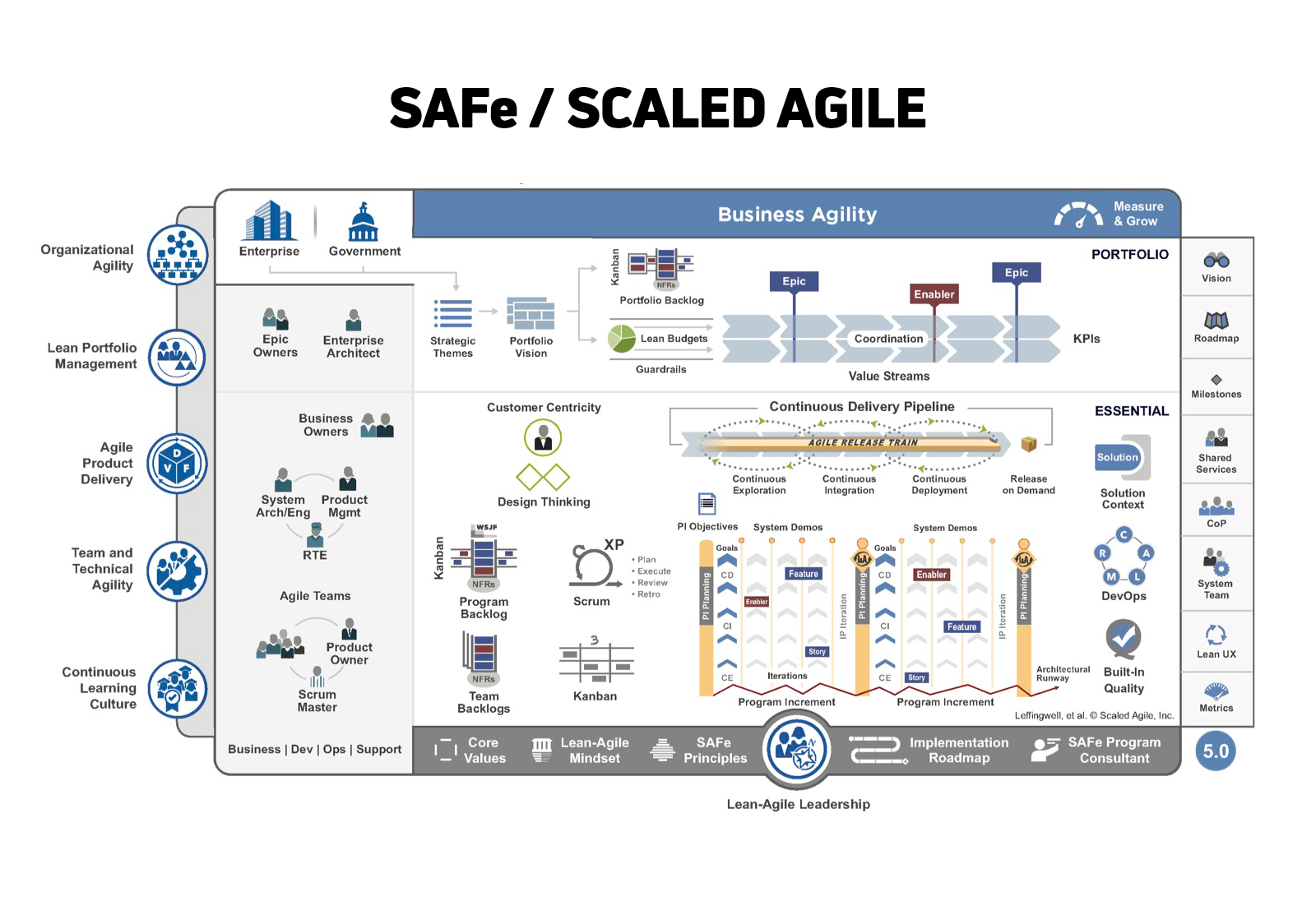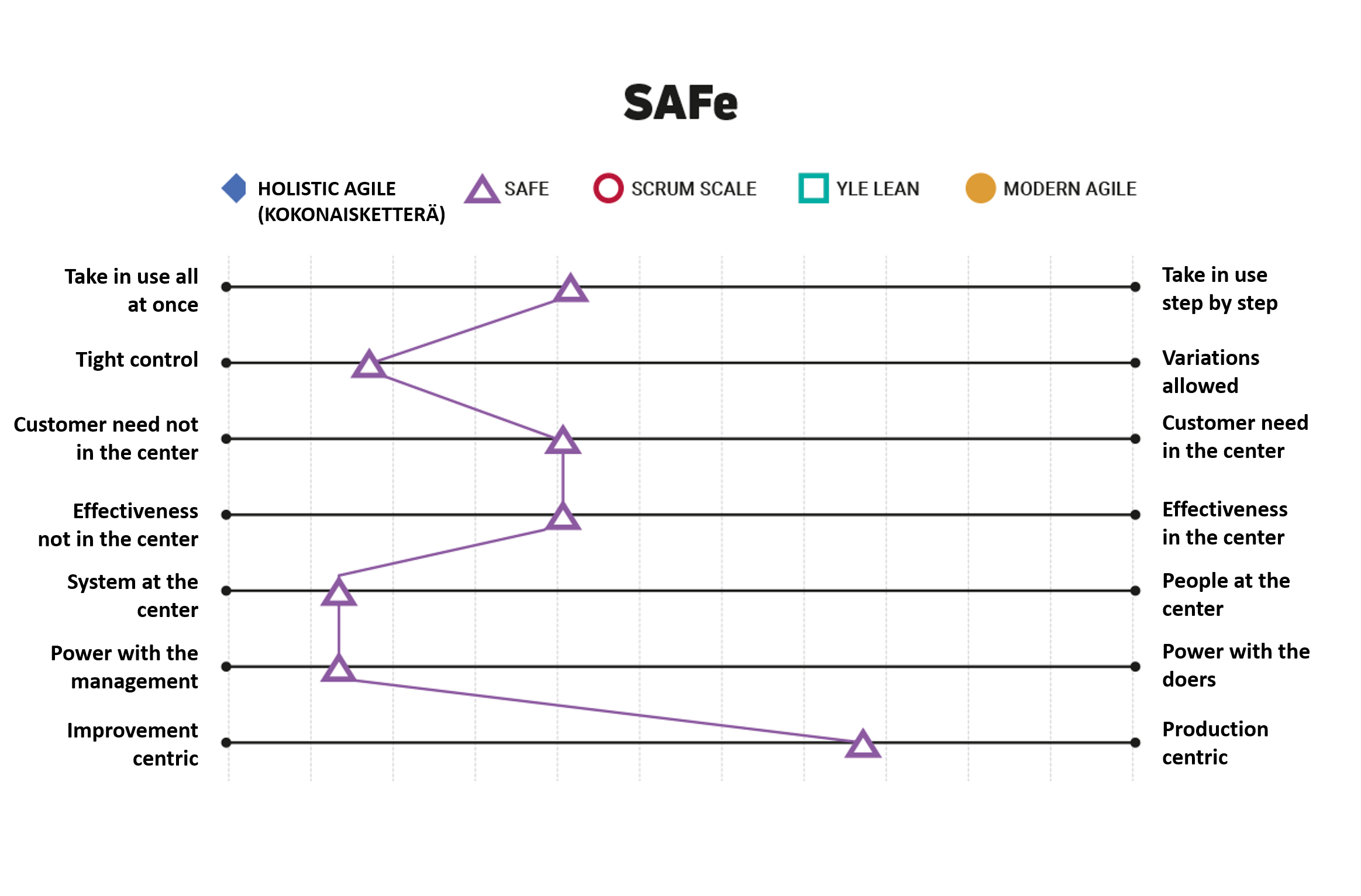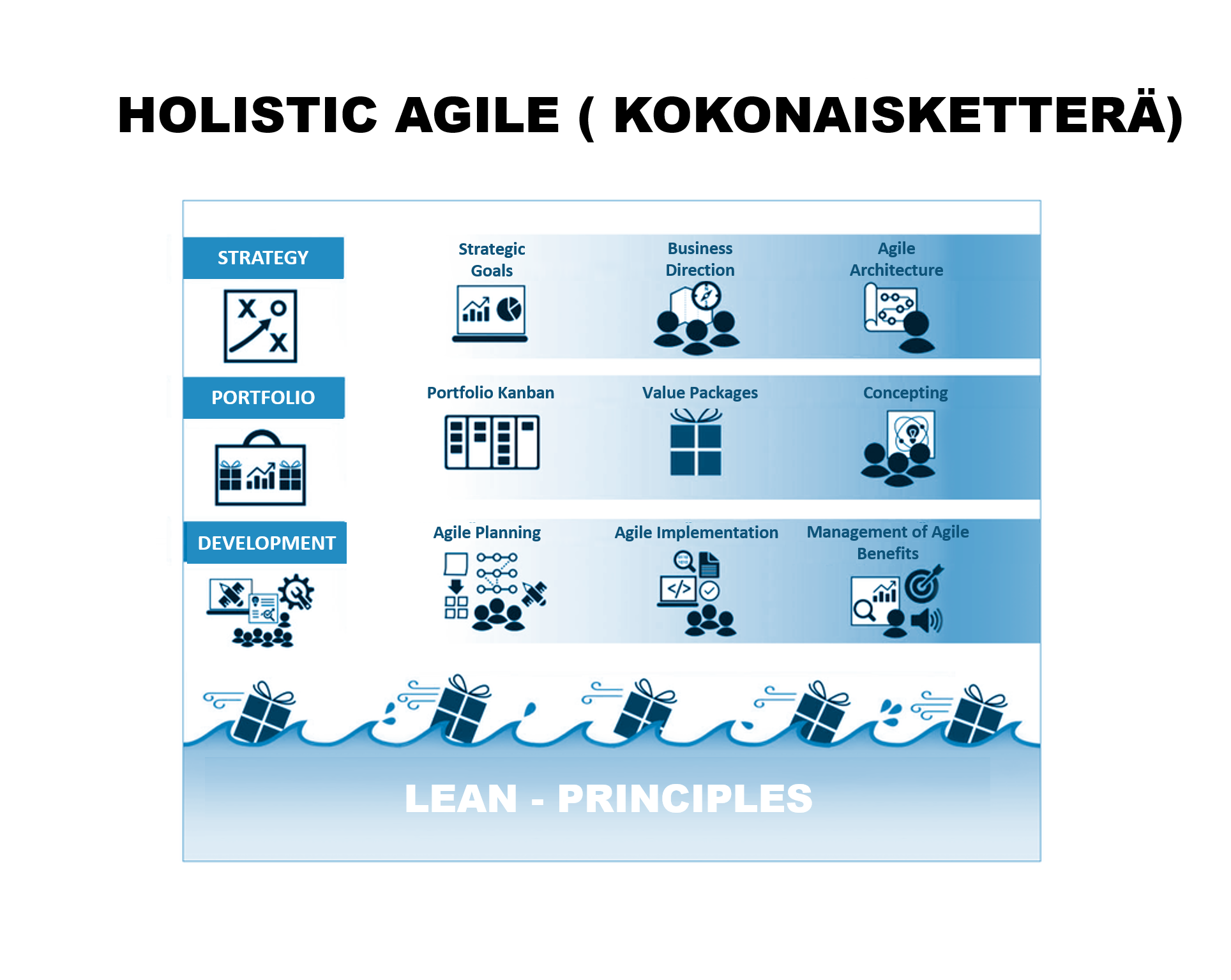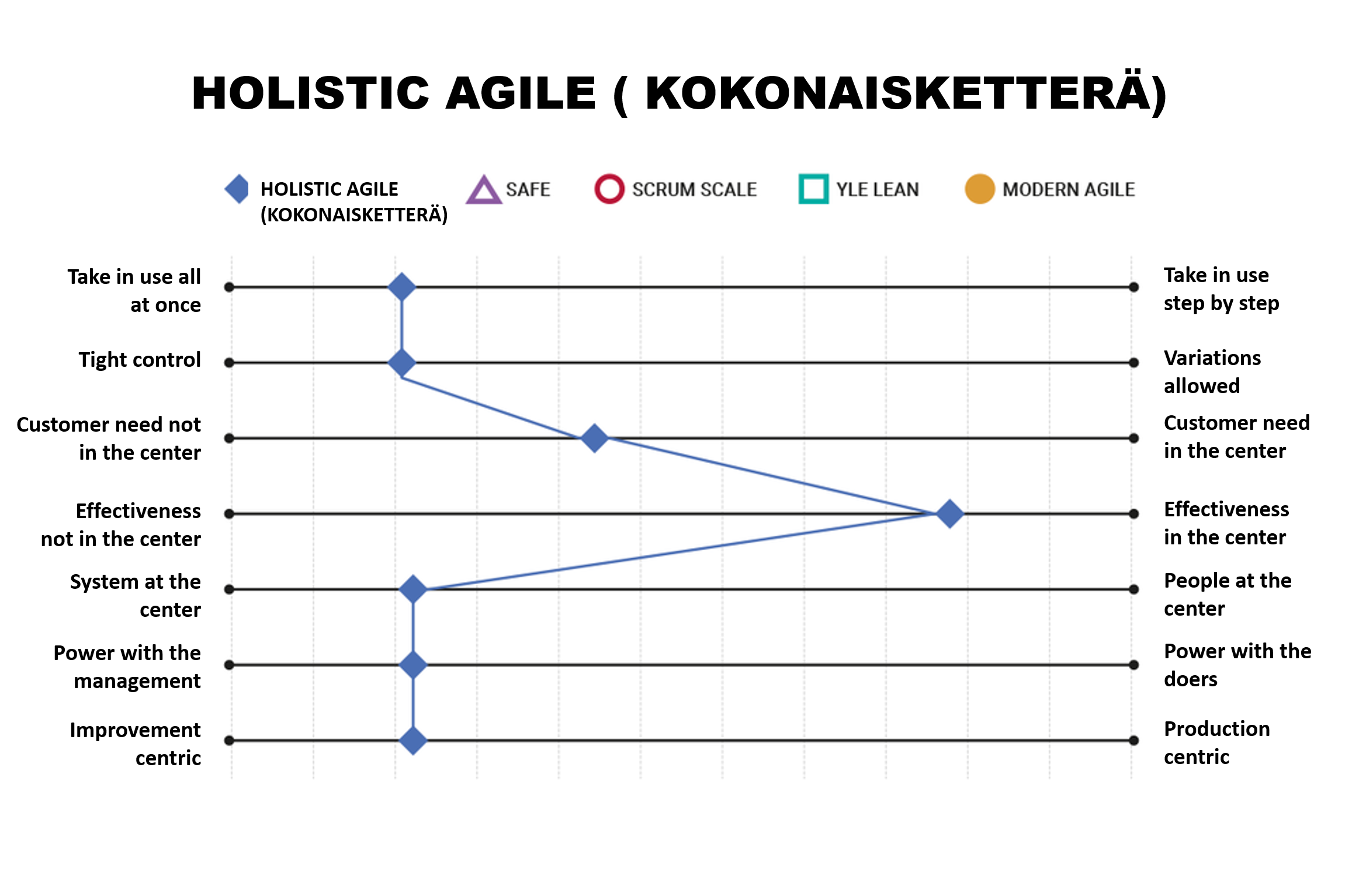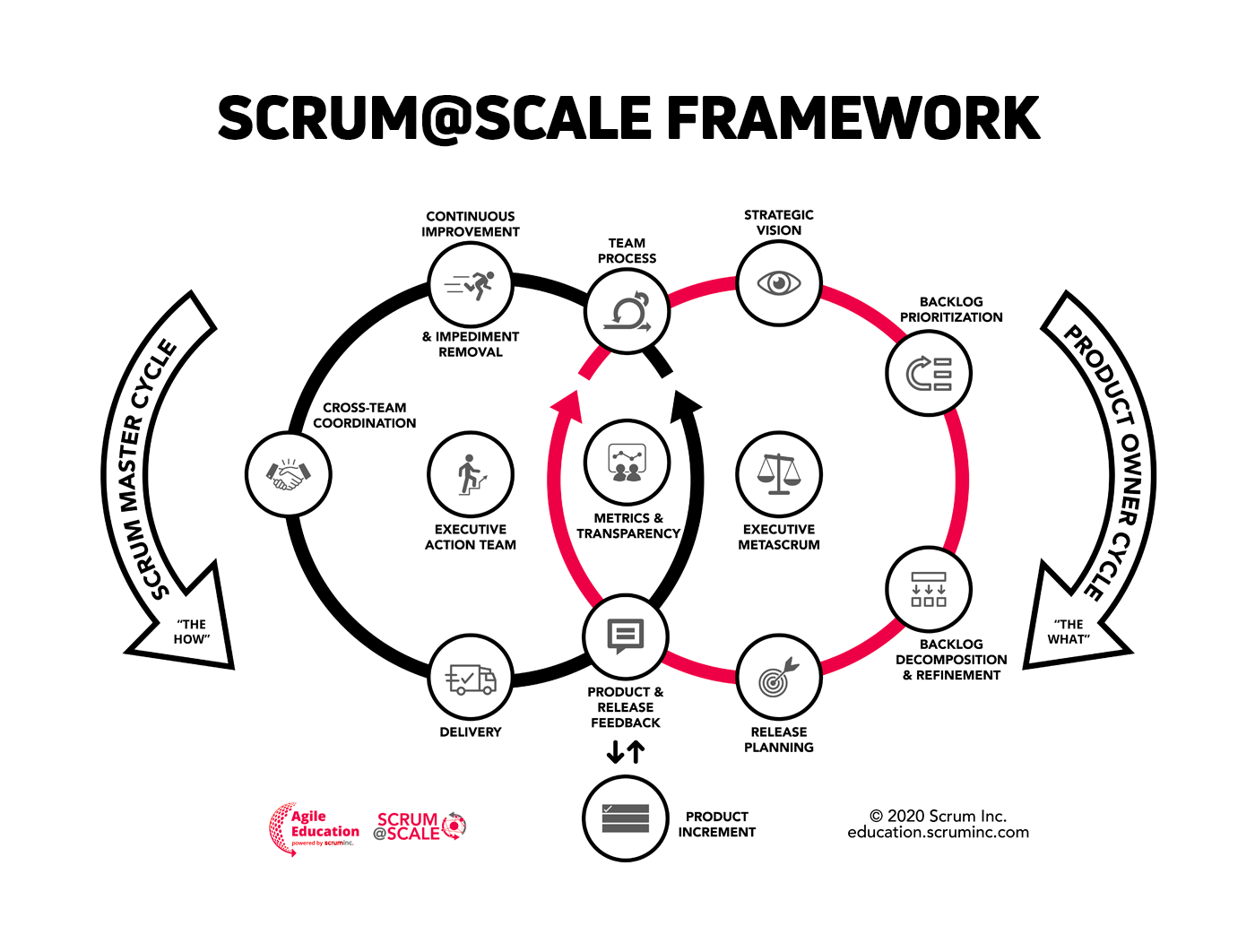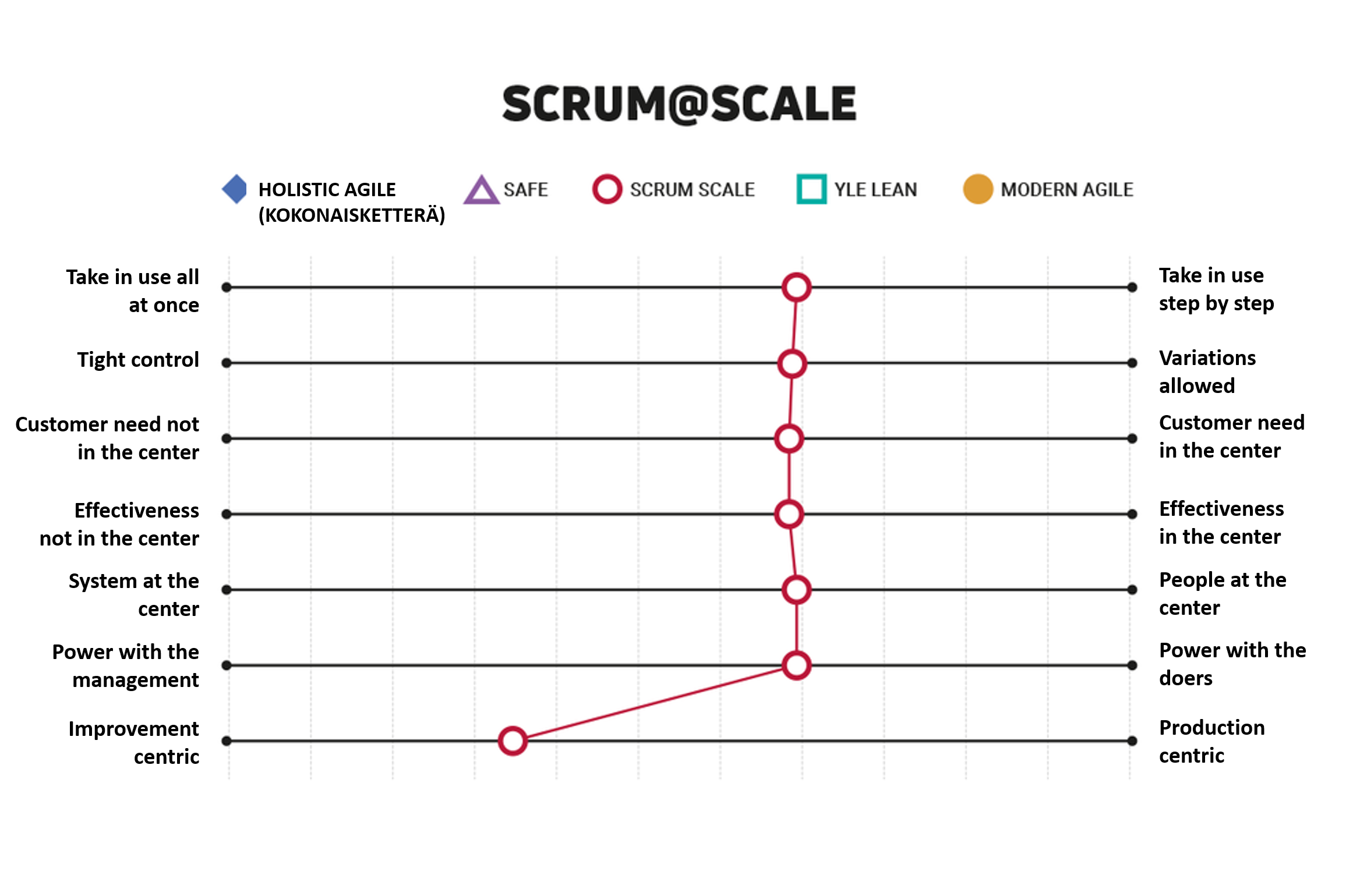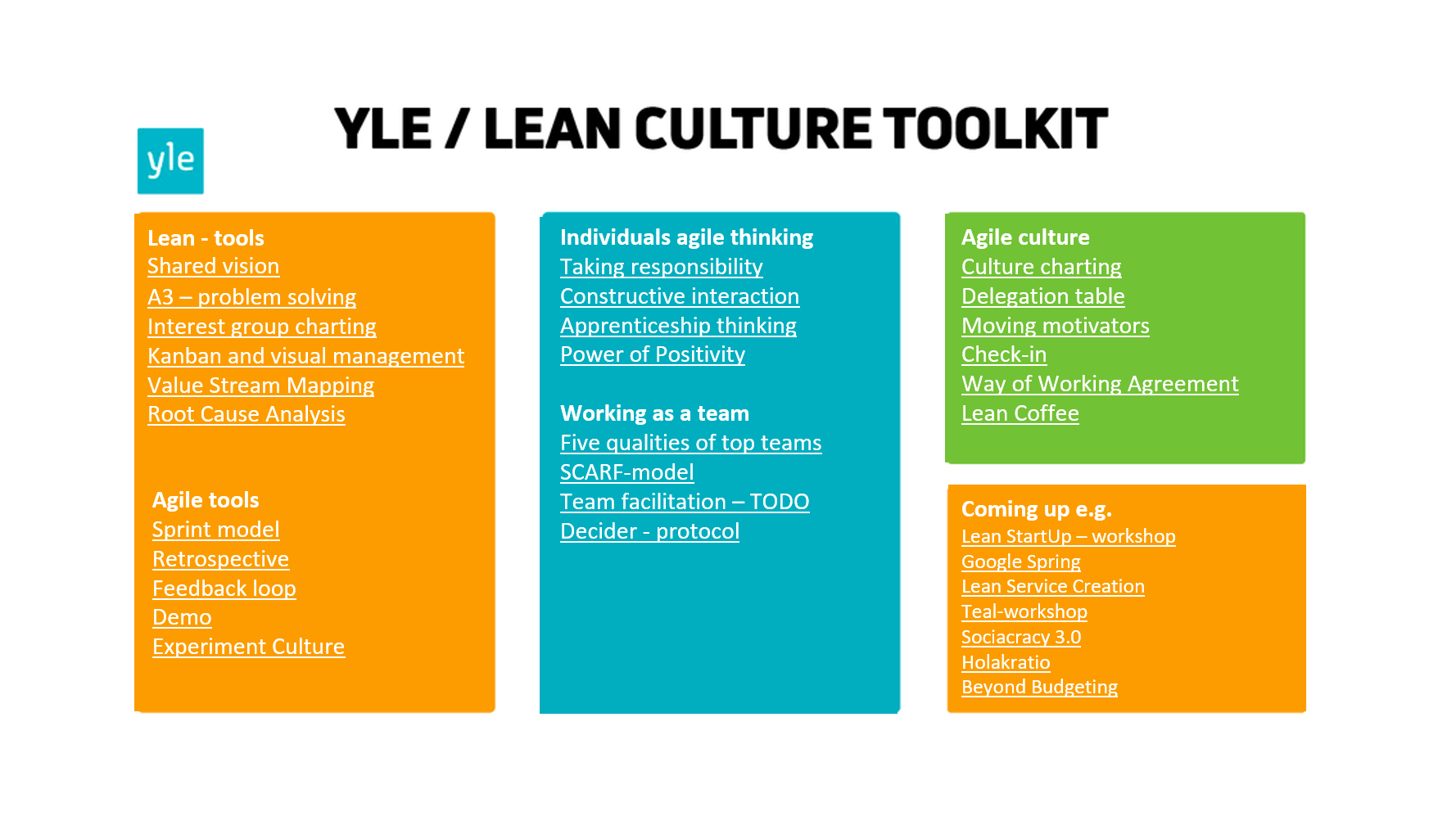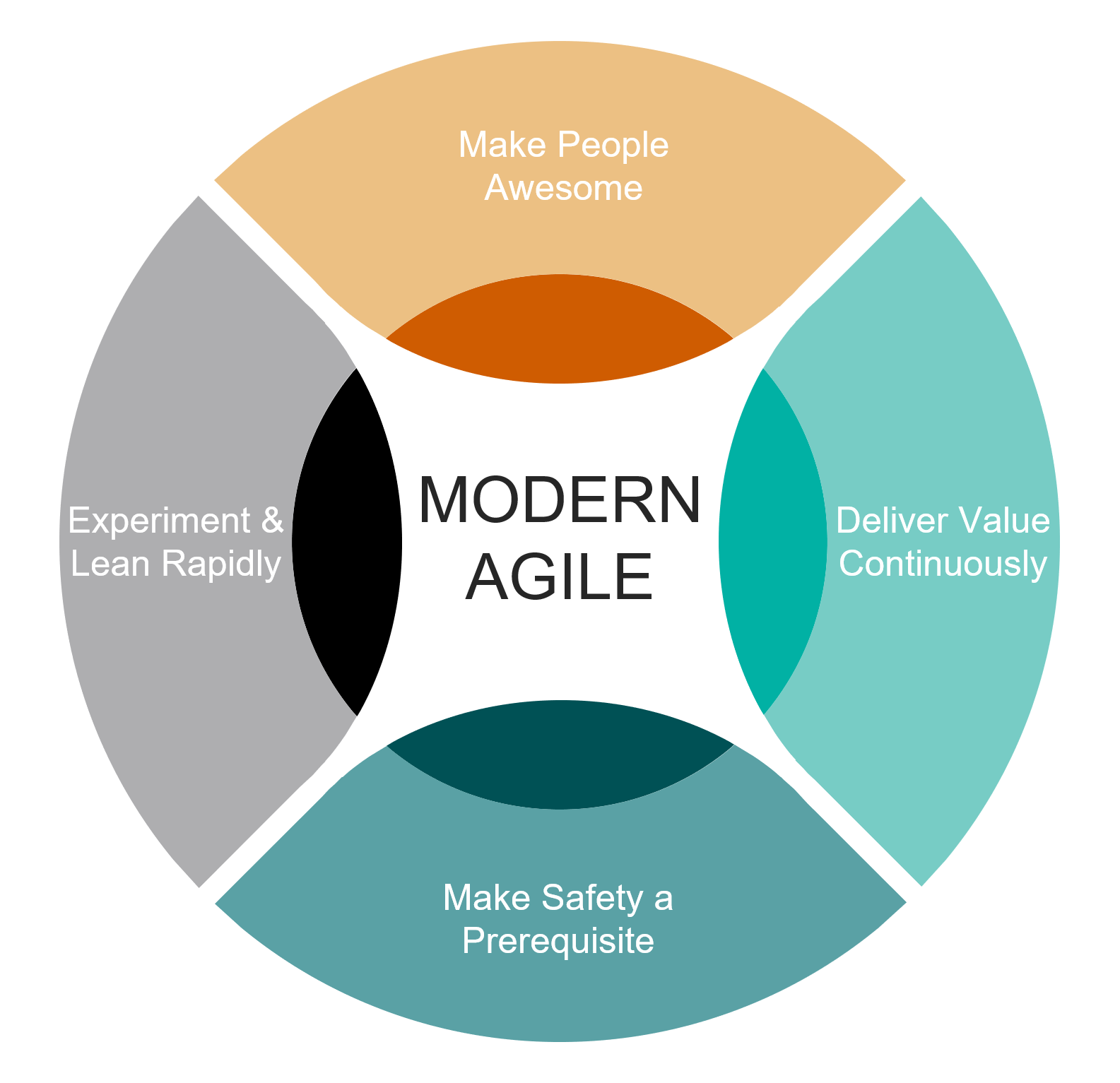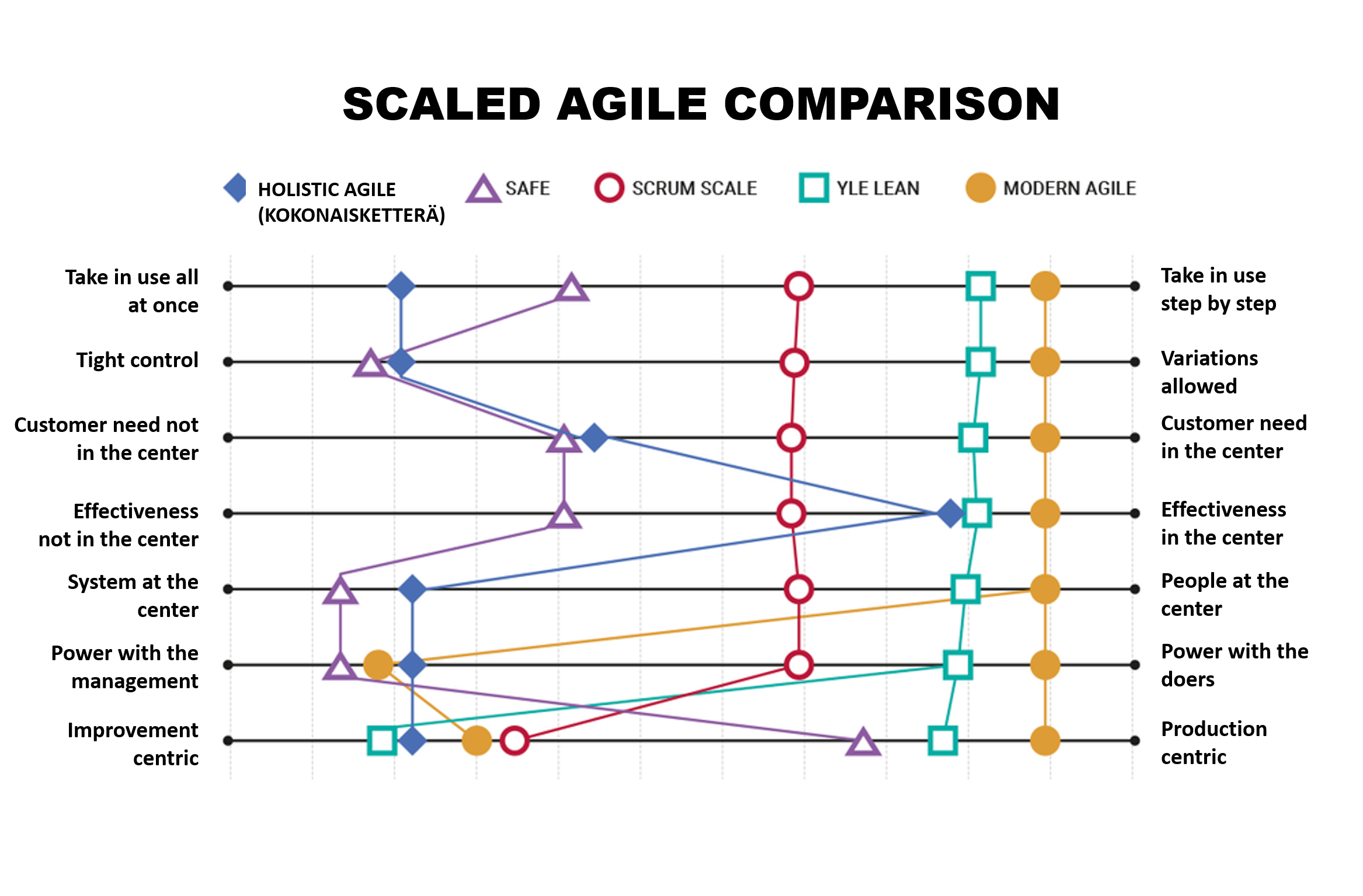SAFe, Scrum@Scale, tailored scaled framework or something else? - Comparison of scaled agile methods
Kuva: Alex Rosario, Unsplash.
After using agile methods for a while, there are usually two scenarios where one starts to consider scaling the agile way of working up:
1. Different development teams starts to have dependencies and need synchronizing
2. Management style do not work with agile development. Portfolio and people management needs new approaches.
That is when there starts to be interest towards scaling agile and re-assessing the management systems.
Regardless of which methods for scaling agile development and refining management are considered, certain basics need to be considered and decided on. In short, when starting, consider at least the following:
Effectiveness: How to ensure that the development and the operation in general produces wanted results?
Control vs. variation: How to govern the development towards wanted direction? Is tight central control the way to go or will variation on development methods be allowed?
Customer need: How to ensure that customer needs are taken into account and effectively met?
Improvement vs. operation: Are we doing improvement work or is the work in question operational in nature? Are these managed differently or via same governance model?
Management in control - experts in control: How much are the empolyees wanted to be taken in to decision making? On what level are the decisions made?
System centric - people centric: Is the system in the center, or people doing the work? Is the emphasis more on reporting and a uniform approach, or on managing motivation and psycological safety?
Taking the new management in use: When the management system is altered, is it more about a one go or step by step pilots and learning?
Next in this article, we will use these criteria to compare a few of the methods for scaling agile development. In comparison we have SAFe, Scrum@Scale, the Finnish local invention Kokonaisketterä (Holistic Agile), Finnish Broadcasting Company’s bespoke Lean Culture model and Modern Agile. All of them are widely used or raising stars in Finland (most of them also abroad). Obviously there are other methods too, and their variations in organization specific adaptations.
Methods for scaling agile and management approaches have beed deviced from variety of starting points and for different contexts. When assessing which of the methods would fit the needs of one’s own organization, it is good to assess the operational landscape (what and where is developed) and the organization’s ability to change (what is the culture and what is the attitude towards change).
SAFe - Robust option for hierarchical organization
SAFe has beed the most widely used method for scaling agile in Finland and worldwide for the past years. It is wide and aims to explain and formalize all the development related activities. It comprises of several similar parallel portfolio, train etc. functions and targets to synchronize both product and service development silos.
SAFe aims to have a synchronized whole where roles and the way of working support portfolio and management lead development.
In SAFe it is thought that effectivenes comes from the whole system following rigorously the same rules and cadences. Control is realized via well defined methods, roles and synchronising. Reacting on customer need is built in but as the planning is separated on several layers, fast reactions to customer needs are sometimes difficult. As a wide development framework SAFe binds widely into operations and is at its best when it’s used in the whole organization.
SAFe is hierarchical and the most impactful roles are usually run by management. Functionality of the methodology is ensured by complying to the system closely - people are not that much in focus. Variety of improvement roles however are described in detail.
When taking SAFe in use, pilots are often used to ensure smooth large scale implementation. Full benefits from SAFe realize only after full deployment, so when considering SAFe as an option, see to the possibility of taking it fully in use within the organization.
Should this be impossible, it’s good to at minimum ensure that the rest of the mode of operation offers compatible functions to govern the development. SAFe as a framework is a wide set of tools and practices, developed and released as versions. This means that should there be organisational adaptations done in using it, upgrades to next version of the SAFe might be tricky.
How is improvement compared to operation in SAFe? SAFe approaches a lean ideal where production equals improvement. There is no separate project organization but the releases are assumed to take care of the improvement needs of an organization. This being the case SAFe is for a holistical product or service creation organization.
Holistic Agile (Kokonaisketterä) - shapeup for portfolio management
Holistic Agile method (in use e.g. in Finnish Digital and Population Data Services Agency) is a Finnish adaptation on scaled agile. It has a clear emphasis on portfolio. Therefore it is suitable for organizations whose challenges include service or product development synchronization and target setting. Agile architecture’s importance is highlighted to help to ensure effectiveness. Holistic Agile emphasizes the results of the development and measuring. The model is quite control focused - people and managing them do not gain a central role.
Effectiveness and results are very important on Holistic Agile. Tight control is seen as the method to achieve them. The eternal balancing between customer centricity and strategy focus is tipped in favour of strategy. The methodology focuses strongly on development, not on broader mode of operation of the organization.
To ensure strategic goals Holistic Agile has a strong target and measurement governance system. This in turn means that in traditional organizations, the power for making decisions is firmly in hands of the management. The system is at the center over people and human interaction.
Because of the several interlinking measuring techniques, the implementation of Holistic Agile is easiest to do all at once. It’s effective usage requires that all the parts of it are in use from the get go.
Because of the systematic measurement, Holistic Agile is an effective method framework.
Scrum@Scale - scrum in wider product development
Scrum@Scale focuses on synchronizing several Scrum teams, like it’s rivals Nexus and LeSS. Of these three Scrum@Scale is most used worldwide and focuses most on what is done on the development. Nexus and LeSS in turn focus more on the development process and technical quality.
Scrum@Scale is best suited for product development where develoment is well resourced and where the number of products being developed is small - meaning that there is not too much need for a strong portfolio management. Scrum@Scale emphasizes the effectiveness of development and has measurement of the deliverables at its center. Also strategic roadmap planning, feedback gathering from the releases and continuous process improvement are highlighted.
Control is not particularly strong in Scrum@Scale. The method is based on Scrum, which regardless on its defined structures gives a lot of freedom to adjust on practical level. It emplasizes that prior to scaling the organization, we should have one working example of the Scrum running. That is then used as a template and copied throughout the organization. Therefore Scrum@Scale is more natural to take to use team by team than SAFe or Holistic Agile.
Scrum@Scale’s ethos has, like Scrum, developers at the center. Those who develop have a lot of power in form of practical decisions on work. Scrum@Scale builds and expands on that notion by stating that the Product Owner forum coordinates also how the strategic vision is realized in development work. People are more central than the system, and it is the role of the system to help workers to focus on value adding and constantly improving way of developping.
If organization has already working Scrum based development, the Scrum@Scale is natural way to scale up. Deployment can be started on a team level and finetune first one implementation example and then clone that for scale with an coordination layer.
Finnish National Broadcoasting Company Yle’s Lean Culture - tools to govern people
The Finnish National Broadcasting Company Yle has a bespoke Lean Culture toolkit, which is quite well known and appreciated in Finland. The toolkit is a hand picked collection of good lean, agile and self governance practices. The practices are adapted to the company’s context and maintained by Yle employees.
The toolkit is a mature agility framework for professionals. It does not have rigid methodological control, but opennes and dialogue are the central ways for needed control. Technical quality is achieved elsewhere, and Lean Culture Toolkit concentrates on governing the development culture.
In Yle’s approach and especially the way the approach is applied within the company, the effectiveness of the development is at center however. Development work has a tight link with strategy and targets. Customer feedback and anticipating the customer needs are fundamental for effectiveness in this methodology. For this to work, transparency is an important enabler.
Yle’s Lean Culture allows variation. Power is with the makers and people are cared of. The role of management is to enable development work via dialogue.
The model is modular by design and can be taken in use one part at the time. Yle Lean Toolkit offers modules that enable agile steps to be taken within existing organization and culture. This allows gradual cultural change towards agile. No big investments are needed upfront but it is possible to start small and grow. Yle’s model is much more flexible than for example Scrum@Scale, but it still offers tangible tools.
Modern Agile and other adaptable frames - one bottleneck at the time
Modern Agile and it’s likes, like e.g. ScALeD which was briefly a topic on discussions back in 2014, are applicable to organizations who are capable and willing to develop solution of their own. They are compact agile management principles that need to be complemented by concrete way of working agreements.
Modern Agile can be seen as a return to most essential agile principles. It does not instruct how the principles should be taken into reality. Emphasis is on finding and agreeing the way of working together, always selecting just the right tool for the context and need in the organization. At the best, this builds very robust agile culture which can and will evolve over time to stay effective.
In Modern Agile customers and employees are at center. Helping people to learn and grow is central, and value to customers is being done in fast cycles. Power is with the ones doing the development work, and smooth operation of the whole is achieved by interactions between people.
Management role is to support development work. Management is done via objectives, not at the implementation level. Communication is more important than the process descriptions, and continuous improvement ethos is strong.
Effectiveness is central on Modern Agile. The work is done closely with the customers, which ensurers continues and immediate value to the customer. Value creation is improved by fast experiment/learning cycles. Variation is kept at bay by focusing on collaboration.
Modern Agile does not tell whether the control is with management or with emloyees. In practice, however, the requirement for fast learning cycles dictates that the people operating in accordance of the Modern Agile need to be committed and able to make needed decisions fast. That in turn means that employee needs must be well taken care of.
Modern Agile and it’s likes rely on principles and is therefore agnostic if it is used for development or as an overall operative model. The lean ideal of having continuous improvement build in to operations is well achievable.
Implementation of Modern Agile can be started immediately on the parts of the organization that are ready to proceed. Also the implementation intensity can be adjusted per needs. In practice, adaptation works best when management system bottlenecks are identified and practical solutions and tools are implemented to solve them.
Modern Agile and it’s likes are methods that are strongly adaptative to organization’s context and can be used to build agile scaling and needed management. They emphasize principles and do not instruct how each of the principles are implemented. This means that the organization considering taking them in needs either in-house understanding or help with the practical agile tools and management techniques and well working experimenting mechanism to identify what really worked. This may seem daunting but the promize is that by walking this path, the organization will find a management model that fits its needs.
Comparison of the scaled agile methods
One bite approach vs. modular methods
Methods for scaling agile development can be divided into two types. Firstly, holistic models are basically designed to be taken in use as a whole, like SAFe, Holistic Agile (Kokonaisketterä), and Scrum@Scale and its rivals.
Second type consists of those methods that trust that organizations can take small steps to increase agility. This approach is to take agile solutions in use where there are most acute needed, in the existing context. Examples of these tailored, modular and value based solutions mentioned here are Modern Agile and a concrete example of the approach, the Finnish Broadcasting Company Yle’s Lean Culture.
The important question to ponder is not which approach is better, but rather what is needed in the organization and what the context is capable of. Is it necessary to replace existing leadership with something substantial right away, or is there rather need for identifying bottlenecks and fixing them towards the new direction one improvement at the time?
Development vs. operations
Having a development focus is not a surprise when we are talking about development frameworks. Methods for scaling agile are mostly created to solve problems of (product) development, and operations are besides the point when it comes to them. So they are best fitted for large scale product or service development. SAFe has a bit of different approach, since it fits well to organizations that have simultaneously several products or services under development and in production use. Modern agile and Yle Lean Culture for their part are so loosely defined that they fit to both improvement and operations setups, as long as the operations have also some continuous improvement going.
Agility is needed both for development and improvement
Problems of development include mode than just listening to the customer and implementing right things. When methods are improved one must consider also the inertia and slowness from the previous mode of operations. There are some inherent thought models associated the service provided. Also the organization providing the service is considered to be certain way.
Agile thinking can well be used for internal development of the organization. Is the situation such that improvement can be planned and then executed? Or is the organization part of an operational environment where we cannot know how some way of working improvement will play out? If the latter, then it pays off to do the way of working improvements in agile manner, fast cycles and continuously learning.
What fits for an organization, dependends on the culture of the organization. Is it defined and strict, in which case ready made holistic approach might be to way to go? Or is experimenting part of the DNA, in which case small investigating steps and tailoring based on learning might be the more appropriate way?
WAlk your own way and you will know where you are
Specific tools often work better than general all purpose ones. It is tempting to take in use tools and working practices that other organizations have tested - no more teething problems. However, the contexts of the other organizations are not the same as yours. If the adaptation needs re neglected, there is risk ending into “not working here” phenomena. That tells more about the inability to adapt tools into the context than wether the method could have worked or not.
Tailoring the agile management system or operational model might seem like a daunting task and heavy solution, but the benefit is that easy start is possible. Also it is always possible to concentrate on the questions that are most important for the organization. One must also consider the know how accumulated into the organization whilst solving the problems case by case. Yle’s approach is a good example about the capability that is gained when organization adapts those methods that serve it the best.
Selecting skaled agile method - what are the steps?
When it is time to consider scaling the agile developent and management within organization, one can use the following questions to start with:
Where do we believe the world is going and how do we want to ride along? How fast are reactions that are needed from us?
From what kind of players could we learn from on how to scale agile?
Where are we now with our mode of operation and our culture? Are we accustomed to planning and well-formed way of working definitions, or are we nimble experimentors?
How much do we want to invest on selecting the method and on its continuous improvement?
What are the most important metrics for us for telling our scaling of agile is successful?
When can we start the first experiment towards the scaled agile, and what will that be?
Below you can find additional information on the methods mentioned in this article:
The Finnish National Broadcasting Company Yle’s Lean Culture toolkit (in Finnish) and Yle’s agile demos (in Finnish)



